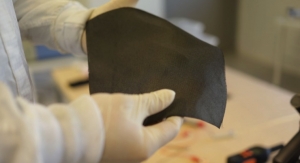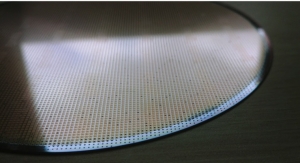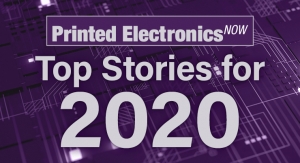Letizia Diamante, Graphene Flagship05.13.20
Alexandr Talyzin works at Graphene Flagship Partner Umeå University, Sweden, and has extensively studied graphene and related materials since 2007, collaborating with the Graphene Flagship since its inception back in 2013.
Initially leading research projects into hydrogen storage technologies, he changed his focus to supercapacitor materials in the recent phase of the project, remaining well-at-home in the Graphene Flagship's Energy Storage Work Package.
His research comprises a variety of carbon nanomaterials, including fullerenes and carbon nanotubes, and more recently, graphene and related materials.
Talyzin spoke about his background, motivations and vision for the future.
He hopes to see a world enriched by graphene and related materials, and gives the Graphene Flagship a valuable glimpse into his efforts to incorporate these materials into the next generation of supercapacitors and energy storage devices.
What made you first start working with graphene and related materials?
Back in 2007, I started doing fundamental research into the properties of graphite oxide. Later on, I expanded my studies to focus more on potential applications and started looking into porous graphene-based materials as well. During the ramp-up phase of the Graphene Flagship, my team investigated hydrogen storage in graphene and related materials. Then we shifted our sights to electrode materials for supercapacitors.
Why did you change your focus from hydrogen storage to supercapacitors?
Graphene and related materials are still some of the best materials for hydrogen storage, but we are far from satisfying the current industrial requirements. This is why we decided to focus on different short-term goals, taking advantage of the great promise of porous graphene and related materials for a number of other applications. Since we have a lot of experience preparing activated graphene with a high surface area, we launched an investigation into new ways of producing liquid dispersions for the preparation of supercapacitor electrodes.
Why is it important to investigate supercapacitors?
In order to achieve sustainable energy solutions, we need a new generation of energy storage technologies. Supercapacitors could help us to reach this goal. These devices are already used in many applications, such as in engine starters for electric cars and locomotives, which require a high amount of power over a short time, and in kinetic recovery systems, to generate energy from a braking vehicle as it slows down.
Improving the energy storage properties of supercapacitors will further broaden their applications. Researchers are continually testing new materials, electrolytes and electrode designs to achieve supercapacitors with energy storage capacity that is comparable to batteries. However, for real progress to happen, we need to grow and nourish a deep understanding of these materials' fundamental properties. For example, the mechanism by which ions are adsorbed and released from electrodes' pores is not yet well-understood, and this information could shape the design of future materials.
How do supercapacitors compare to batteries?
Currently, batteries are used to store larger amounts of energy, while supercapacitors are better for power peak demands because they give off energy more quickly. Supercapacitors can provide a faster and greater number of charge-discharge cycles than rechargeable batteries with less degradation after each cycle, resulting in longer lifetimes. At present, however, batteries are more common due to their greater energy density, meaning they can store large amounts of energy while having a low mass.
In general, good supercapacitors contain electrodes with very high surface areas. The high surface areas can host more ions, resulting in improved energy storage. For this reason, today's commercial supercapacitors use activated carbon electrodes: a material rich in pores with a very high surface-to-volume ratio. We hope that graphene and related materials will take these effects even further and allow us to achieve competitive storage capacities.
How can graphene and related materials improve supercapacitors?
Graphene is a promising material for the enhancement of supercapacitor performance. This is due to its high conductivity, which is extremely valuable for these systems, and because we can use it to fabricate porous structures with very high surface areas. However, the performance of graphene-based electrodes is still below theoretical values.
As graphene sheets are assembled into porous materials to be used as electrodes, the properties of the supercapacitors are contingent on the methods of deposition and preparation. The most convenient method is to use inks or dispersions based on graphene and related materials – in fact, we recently published a paper with a new formulation for water-based graphene ink. We are very proud that it generated a lot of media attention.
What are the advantages and ideal properties of water-based inks?
Water is the easiest and most environmentally friendly solvent for the preparation of dispersions. Simultaneously, graphene and related materials provide high surface area and good conductivity. Both of these features are required for good supercapacitor electrodes.
There is a strong industrial demand for water-based graphene and related-material dispersions, as they are more environmentally friendly than those produced with organic solvents. We can apply dispersions onto surfaces using simple methods, such as blade or brush deposition, or adapt them for spray deposition and inkjet printing.
Dispersions must be stable and have the right concentration for the specific deposition method. They must also provide materials with a high surface area and good conductivity after drying, adhering well to the electrode substrate.
What are the challenges of producing these inks?
Both reduced graphene oxide (RGO) and activated RGO (a-RGO) are hydrophobic, so it is difficult to prepare aqueous dispersions that are sufficiently concentrated and stable. Retaining the porous structure of a-RGO's is also a challenge. In addition, once the ink is deposited and the solvent has evaporated, the graphene sheets in the dispersion can restack to form graphite-like structures – so the high surface area is lost, and the electrode performance decreases.
How do you deal with these challenges?
Typically, specific organic solvents are used in combination with mechanical treatments and surfactants. Mechanical treatments might mean hundreds of hours of sonication, resulting in just a small concentration of graphene in water – less than half a milligram per milliliter. Adding surfactants or organic solvents helps to increase the concentration, but these substances may be toxic, not conductive and are difficult to remove after electrode deposition.
We, therefore, set out to develop a different method. Vasyl Skrypnichuk, a postdoctoral researcher at Graphene Flagship partner Umeå University and member of our group, proposed using a combination of a-RGO and GO. This worked really well to prepare stable dispersions. The addition of carbon nanotubes and fumed silica made the dispersion stable for days and helped us to achieve graphene solutions with concentrations of up to 20 milligrams per milliliter – 40 times greater than that from standard mechanical treatments – with good adhesion to metal foils and improved flexibility. Furthermore, the resulting ink had a high surface area and conductivity, demonstrating the effectiveness of our new method.
What are the next steps for your group?
It would be very exciting to prepare fully functional flexible supercapacitors.
We have already prepared liters of our dispersions, and we are going to test different deposition methods on a larger scale, in collaboration with our partners. We will be undertaking more work to optimize the dispersion formulations and deposition methods in order to produce homogeneous electrode films over larger areas and to achieve good adhesion and flexibility on a variety of industrially relevant metal foils.
Thanks to the support from the Graphene Flagship and the Umeå University Innovation Center, we have filed a patent application of our dispersion preparation method. The next step is to convert our results and our designs into real industrial products.
Initially leading research projects into hydrogen storage technologies, he changed his focus to supercapacitor materials in the recent phase of the project, remaining well-at-home in the Graphene Flagship's Energy Storage Work Package.
His research comprises a variety of carbon nanomaterials, including fullerenes and carbon nanotubes, and more recently, graphene and related materials.
Talyzin spoke about his background, motivations and vision for the future.
He hopes to see a world enriched by graphene and related materials, and gives the Graphene Flagship a valuable glimpse into his efforts to incorporate these materials into the next generation of supercapacitors and energy storage devices.
What made you first start working with graphene and related materials?
Back in 2007, I started doing fundamental research into the properties of graphite oxide. Later on, I expanded my studies to focus more on potential applications and started looking into porous graphene-based materials as well. During the ramp-up phase of the Graphene Flagship, my team investigated hydrogen storage in graphene and related materials. Then we shifted our sights to electrode materials for supercapacitors.
Why did you change your focus from hydrogen storage to supercapacitors?
Graphene and related materials are still some of the best materials for hydrogen storage, but we are far from satisfying the current industrial requirements. This is why we decided to focus on different short-term goals, taking advantage of the great promise of porous graphene and related materials for a number of other applications. Since we have a lot of experience preparing activated graphene with a high surface area, we launched an investigation into new ways of producing liquid dispersions for the preparation of supercapacitor electrodes.
Why is it important to investigate supercapacitors?
In order to achieve sustainable energy solutions, we need a new generation of energy storage technologies. Supercapacitors could help us to reach this goal. These devices are already used in many applications, such as in engine starters for electric cars and locomotives, which require a high amount of power over a short time, and in kinetic recovery systems, to generate energy from a braking vehicle as it slows down.
Improving the energy storage properties of supercapacitors will further broaden their applications. Researchers are continually testing new materials, electrolytes and electrode designs to achieve supercapacitors with energy storage capacity that is comparable to batteries. However, for real progress to happen, we need to grow and nourish a deep understanding of these materials' fundamental properties. For example, the mechanism by which ions are adsorbed and released from electrodes' pores is not yet well-understood, and this information could shape the design of future materials.
How do supercapacitors compare to batteries?
Currently, batteries are used to store larger amounts of energy, while supercapacitors are better for power peak demands because they give off energy more quickly. Supercapacitors can provide a faster and greater number of charge-discharge cycles than rechargeable batteries with less degradation after each cycle, resulting in longer lifetimes. At present, however, batteries are more common due to their greater energy density, meaning they can store large amounts of energy while having a low mass.
In general, good supercapacitors contain electrodes with very high surface areas. The high surface areas can host more ions, resulting in improved energy storage. For this reason, today's commercial supercapacitors use activated carbon electrodes: a material rich in pores with a very high surface-to-volume ratio. We hope that graphene and related materials will take these effects even further and allow us to achieve competitive storage capacities.
How can graphene and related materials improve supercapacitors?
Graphene is a promising material for the enhancement of supercapacitor performance. This is due to its high conductivity, which is extremely valuable for these systems, and because we can use it to fabricate porous structures with very high surface areas. However, the performance of graphene-based electrodes is still below theoretical values.
As graphene sheets are assembled into porous materials to be used as electrodes, the properties of the supercapacitors are contingent on the methods of deposition and preparation. The most convenient method is to use inks or dispersions based on graphene and related materials – in fact, we recently published a paper with a new formulation for water-based graphene ink. We are very proud that it generated a lot of media attention.
What are the advantages and ideal properties of water-based inks?
Water is the easiest and most environmentally friendly solvent for the preparation of dispersions. Simultaneously, graphene and related materials provide high surface area and good conductivity. Both of these features are required for good supercapacitor electrodes.
There is a strong industrial demand for water-based graphene and related-material dispersions, as they are more environmentally friendly than those produced with organic solvents. We can apply dispersions onto surfaces using simple methods, such as blade or brush deposition, or adapt them for spray deposition and inkjet printing.
Dispersions must be stable and have the right concentration for the specific deposition method. They must also provide materials with a high surface area and good conductivity after drying, adhering well to the electrode substrate.
What are the challenges of producing these inks?
Both reduced graphene oxide (RGO) and activated RGO (a-RGO) are hydrophobic, so it is difficult to prepare aqueous dispersions that are sufficiently concentrated and stable. Retaining the porous structure of a-RGO's is also a challenge. In addition, once the ink is deposited and the solvent has evaporated, the graphene sheets in the dispersion can restack to form graphite-like structures – so the high surface area is lost, and the electrode performance decreases.
How do you deal with these challenges?
Typically, specific organic solvents are used in combination with mechanical treatments and surfactants. Mechanical treatments might mean hundreds of hours of sonication, resulting in just a small concentration of graphene in water – less than half a milligram per milliliter. Adding surfactants or organic solvents helps to increase the concentration, but these substances may be toxic, not conductive and are difficult to remove after electrode deposition.
We, therefore, set out to develop a different method. Vasyl Skrypnichuk, a postdoctoral researcher at Graphene Flagship partner Umeå University and member of our group, proposed using a combination of a-RGO and GO. This worked really well to prepare stable dispersions. The addition of carbon nanotubes and fumed silica made the dispersion stable for days and helped us to achieve graphene solutions with concentrations of up to 20 milligrams per milliliter – 40 times greater than that from standard mechanical treatments – with good adhesion to metal foils and improved flexibility. Furthermore, the resulting ink had a high surface area and conductivity, demonstrating the effectiveness of our new method.
What are the next steps for your group?
It would be very exciting to prepare fully functional flexible supercapacitors.
We have already prepared liters of our dispersions, and we are going to test different deposition methods on a larger scale, in collaboration with our partners. We will be undertaking more work to optimize the dispersion formulations and deposition methods in order to produce homogeneous electrode films over larger areas and to achieve good adhesion and flexibility on a variety of industrially relevant metal foils.
Thanks to the support from the Graphene Flagship and the Umeå University Innovation Center, we have filed a patent application of our dispersion preparation method. The next step is to convert our results and our designs into real industrial products.




























